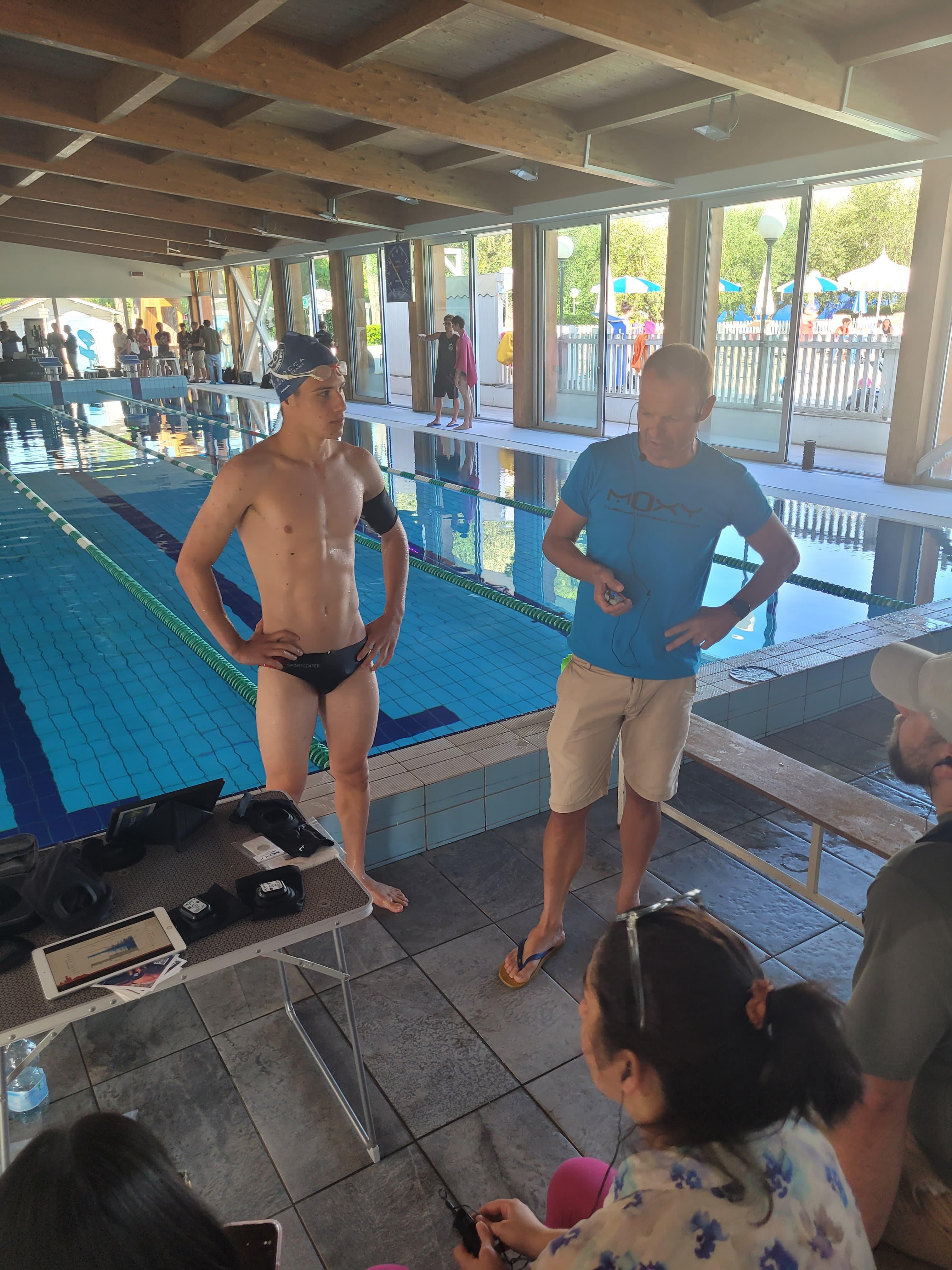How Can Swimmers Use Muscle Oxygen Monitoring to Train Smarter?
Swimming training has always relied on feel, times, and heart rate. But what if you could see exactly how your muscles use oxygen during every stroke? The Moxy Monitor is the only device that works in the pool, giving swimmers real-time muscle oxygen data that transforms how you train.
Why Is Muscle Oxygen Monitoring Game-Changing for Swimmers?
Traditional swimming metrics tell you what happened, not why. Split times show you went slower, but not whether it was due to poor pacing, inadequate recovery, or training at the wrong intensity.
Muscle oxygen saturation (SmO2) reveals the "why" behind your performance by showing:
- How efficiently your muscles use oxygen at different intensities
- Whether you're truly recovered between sets
- If you're training in the right zones for your goals
- Your aerobic capacity improvements over time
Where to Place a Moxy during Swimming
Primary Location: Triceps Muscle
The triceps brachii is the optimal placement site for swimming applications. Position the Moxy sensor on the muscle belly of the triceps, approximately halfway between the shoulder and elbow on the posterior aspect of the upper arm. This location provides:
- Excellent signal quality during swimming strokes
- Minimal interference from stroke mechanics
- Good representation of upper body oxygen utilization
- Secure attachment that stays in place during pool activities
Alternatively, you can place the Moxy on the latissimus dorsii (if you can get it adequately secured), or for lower body measurements, the rectus femoris and gastroc have been used.
How to Secure your Moxy during Swimming
Alternatively, you can use waterproof medical tape or the manufacturer's adhesive attachments to secure the sensor. Ensure the device is completely covered and sealed to prevent water intrusion. The Moxy Monitor is water-resistant, so it should be good for pool use. However, it is not rated for prolonged deep-water exposure, if you are going to be using it regularly, place it in a clear plastic bag for extra protection.
How to Complete Testing with a Moxy During Swimming
1. How to Create an Intensity-Based SmO2 Profile with Moxy
Protocol:
- Perform 50-meter intervals at three different intensities:
- Easy Pace: Comfortable aerobic swimming (70-75% effort)
- Moderate Pace: Steady-state threshold pace (80-85% effort)
- High Intensity: Near-maximal effort (90-95% effort)
- Rest 2-3 minutes between each interval
- Monitor SmO2 during swimming and recovery phases
What to Look For:
- Easy Pace: SmO2 should remain relatively stable or show only minor decreases
- Moderate Pace: SmO2 will decrease during the swim and recover quickly
- High Intensity: Significant SmO2 drop with slower recovery patterns
2. How to Measure Critical Swim Speed (CSS) with Moxy
Critical Swim Speed represents the theoretical fastest pace a swimmer can maintain continuously without exhaustion - essentially their aerobic swimming threshold.
CSS Calculation: Perform two time trials:
- 400-meter maximum sustainable pace
- 200-meter maximum sustainable pace
CSS = (400m time - 200m time) ÷ 2
Adding Moxy to CSS Testing:
- Attach Moxy to triceps muscle before testing
- Record baseline SmO2 at rest
- Perform the 200m time trial first, monitoring SmO2 throughout
- Allow complete recovery (15-20 minutes)
- Perform the 400m time trial with continuous SmO2 monitoring
- Calculate CSS and analyze SmO2 patterns
SmO2 Analysis:
- The pace where SmO2 begins to show a sustained decline typically correlates with CSS
- Swimmers with higher aerobic capacity will maintain higher SmO2 values at CSS pace
- Recovery patterns can identify aerobic fitness and training adaptations
3. How to Measure SmO2 Recovery Rate during Swimming with Moxy
Protocol:
- Perform a standardized high-intensity effort (50m or 100m at 90%+ effort)
- Monitor SmO2 during the swim and for 3-5 minutes of recovery
- Record the time to return to baseline SmO2 (within 5% of resting values)
Applications:
- Faster recovery indicates better aerobic fitness
- Can help determine optimal rest intervals for training sets
- Useful for identifying swimmer specialization (sprinter vs. distance)
4. How to Determine Training Zones during Swimming with Moxy
Protocol:
- Swim at perceived training zones (aerobic, threshold, VO2max)
- Monitor SmO2 response patterns
- Compare actual SmO2 data with intended training stress
Benefits:
- Ensures swimmers are training at appropriate intensities
- Helps identify individual physiological thresholds
- Allows for personalized training zone adjustments
How to Interpret SmO2 Data for Swimming
Swimmer Type Identification
Research has shown that SmO2 patterns can help identify swimmer specialization:
- Distance Specialists: Maintain higher SmO2 values across all intensities and recover more quickly
- Sprint Specialists: Show greater SmO2 drops at high intensities but may have different recovery patterns
Training Applications
Zone 2 (Aerobic Base): SmO2 should remain stable or show minimal decrease
Zone 3/4 (Threshold): SmO2 will decrease but should plateau and recover quickly
Zone 4/5 (VO2max/Anaerobic): Significant SmO2 drops with slower recovery
Why Swimmers Should Use Moxy Monitoring
The Moxy Monitor provides valuable insights into swimming physiology that traditional methods cannot capture. By monitoring muscle oxygenation during various swimming intensities and tests like CSS, coaches and swimmers can make more informed training decisions, optimize recovery protocols, and better understand individual physiological responses to training stress. This technology represents a significant advancement in making sophisticated physiological monitoring accessible to swimmers at all levels.
Regular use of Moxy monitoring can help swimmers train smarter, not just harder, leading to more effective training adaptations and improved performance in the pool.
Want to learn more about how to use Muscle Oxygen for training and racing? Download our FREE eBook Training and Racing with Moxy

Download the Training and Racing with Moxy eBook

